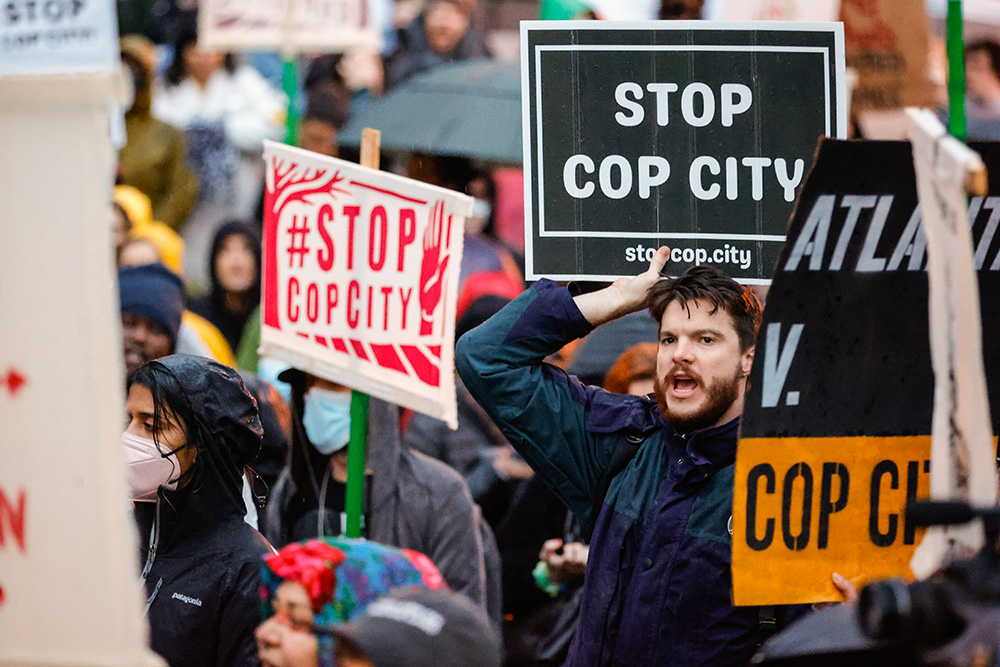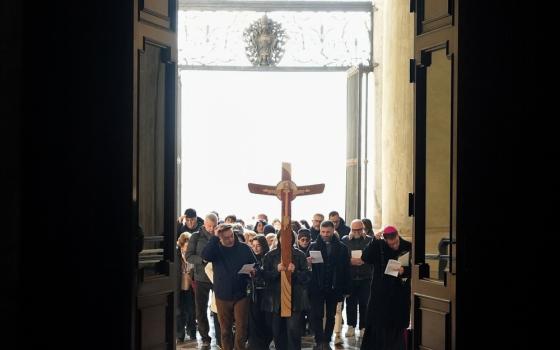
Demonstrators hold signs and chant slogans in Atlanta March 9, 2023, during a protest over plans to build a new police training center in public South River Forest. (AP/Alex Slitz)
In the decades after the Civil War, one of the most popular American boogeymen was the so-called "tramp" or "hobo." From about 1870 to 1910, newspapers were littered with pieces fear-mongering the collapse of society they'd usher in, or cheering police and mob violence against them.
A 1875 New York Times blurb, "How to Treat Tramps," for instance, gleefully recounts how cops threatened two young men with the horrors of a prison labor camp they could be sent to as part of this invading hoard until "their ready tears plow[ed] little furrows down their dirty visages."
In truth, the subjects of the "tramp panic" were working-class men who had been transformed from artisans and small farmers into social problems by the depression of the 1870s and the Industrial Revolution. These itinerant workers were usually without wives and land — things requiring a stability that neither the times nor public policy provided. The problems created by this tumult were "solved" instead by police and incarceration.
With the rise of so-called "cop cities" today, I fear we are at the start of another chapter of the mass criminalization of human need.
The term "cop city" comes from activists resisting the construction of the $109.6 million, 85-acre Atlanta Public Safety Training Center in public South River Forest in Atlanta. It has become a fight that captures many of the themes of our nation's — indeed, our world's — current inflection point.
Most important for Catholics, I think, is how our governments are aligning resources to meet the needs of today's poor and vulnerable in light of the human and ecological crises unfolding before us today.
Advertisement
Atlanta is not alone. State and municipal governments across the country are making massive public and private investments into police training facilities. Researcher Renee Johnston has tracked 69 projects nationwide, ranging from expansions of already-existing facilities to $415 million new projects. The only states that did not have something in the works were North Dakota, Vermont and Wyoming.
Projects range from urban centers such as Baltimore ($330 million) and Newark, New Jersey ($300 million) to small towns such as Hershey, Pennsylvania ($300 million). The irony in all of this is that not only did U.S. crime rates fall once again in 2023, violent crime and property crime fell a staggering 71% from 1993 to 2022, according to data from the U.S. Bureau of Justice Statistics.
While crime is on a decadeslong downward trend, we live amid an explosion of need that exacerbates instability internally, at the border and internationally — all of which are responded to with militarism rather than massive investments in human flourishing.
Domestically, for instance, chronic homelessness is at an all-time high, including among the elderly and families with children. Yet just this April, the Supreme Court heard oral arguments in a case that will decide whether cities and states with insufficient affordable housing — which is all of them, by the way — can legally fine and incarcerate people for sleeping outside.
Just as important as the fact of human and ecological need among poor and working-class people is the fact that these same vulnerable people are organizing and taking part in diverse forms of civic engagement at rates not seen in a generation. That, too, is being harshly criminalized.
With the rise of so-called 'cop cities' today, I fear we are at the start of another chapter of the mass criminalization of human need.
Forty-three states have some form of anti-protest laws on the books, many of them using post-9/11 anti-terrorism framings for the types of nonviolent civil disobedience tactics for which we fondly remember Dr. Martin Luther King Jr. After 15 years of seeing police show up to college campuses and racial justice protests dressed as special forces operatives, cop cities and these legislation are ominous developments.
In the year 2000, the U.S. Conference of Catholic Bishops released a teaching document on crime and criminal justice, "Responsibility, Rehabilitation, and Restoration." At the time, the populations of state and federal prisons had ballooned to 1.3 million from 482,000 in 1980, with millions more in local jails, immigration detention facilities and under supervision on probation and parole. The document was, among other things, a call to protect the common good from both the harms that can arise in communities as well as from what they frame as vengeful policies that are quick to dispose of people through incarceration and execution.
Published at the height of the so-called "tough on crime" era, "Responsibility, Rehabilitation, and Restoration" was an important moral call to respect the dignity of incarcerated people. The document acknowledges racist disparities in incarceration rates, as well as the large number of people incarcerated for drug offenses, with mental illness and with low formal educational attainment.
Yet, they remained unwilling to acknowledge that a very real social function of modern U.S. policing and incarceration is to disappear problem populations. In the face of what's coming — indeed, what's already here — we can't afford to maintain that posture.







